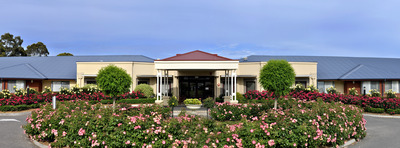High-tech aged care
Thursday, 24 January, 2013
Bethsalem Care is an aged care facility serving the Christadelphian community of Adelaide. For almost 60 years they have provided care and hostel-style accommodation for church members and the wider community. Around ten years ago, the board realised the nature of aged care was changing. Not only was demand increasing, but the community wanted assurance of a graceful transition from retirement to full-time care. In response, Bethsalem Care increased capacity and expanded its range of care options. To facilitate growth, they moved to a new facility comprising 90 high- and low-care residential rooms, with 27 adjoining retirement units.

The change of premises presented the opportunity to incorporate a range of technologies into the building design. Key to the process was the establishment of a proprietary Wi-Fi network that would underpin a computer-based, programmable mobile telephony system. The aim was to create a sophisticated system incorporating nurse call, security, telephone and access. Staff would carry phones while attending to resident care, enabling communication with one another and incoming call access. Handsets would also be used to remotely unlock secure doors.
It was a bold vision and plagued with difficulties from day one. Despite constant complaints and investigations, the network and the converged phone system never achieved full potential. Staff and residents were frustrated by phones that failed to work as expected and a nurse call system that was not integrated as designed.
New CEO Darryl Pitcher arrived in 2010 and was immediately faced with a number of challenges. On his second day the facility went live with a new web-based medication management system that provided a critical flow of information, between doctor, pharmacy and Bethsalem Care. The system relied on tablet PCs fitted to trolleys and linked via the Wi-Fi network. It functioned, but network connections frequently dropped out, leaving the tablets unable to synchronise with the server.
Having a technical and commercial facilities management background, Pitcher quickly realised something had to be done.
“In a healthcare setting, you can’t exist like that,” he notes. “It was apparent that the IT provider was out of his depth when it came to convergence. He wasn’t able to resolve the issues, but told us we had a full working Wi-Fi network with facility-wide coverage.”
Pitcher decided it was time for change. “We needed to replace the phone system with a wireless system that could work on a standard 802.11 network. In addition, we needed to ensure we had a Wi-Fi network capable of meeting our voice and data bandwidth requirements.”
The old telephone system was removed and Bethsalem Care invested in rugged Motorola handsets and a Mitel IP-based system that would work over the wireless network.
When it came to the network upgrade, Pitcher sought the advice of a number of specialists, including Allied Telesis in Melbourne. He described Bethsalem’s large figure-eight-shaped facility, its two secure inner courtyards and the rooms scattered across a large floor area. He explained the critical importance of even, continuous coverage for the tablets and phones.
Pitcher says, “Allied Telesis went all out to scope a system for better coverage. They designed, installed and commissioned a new infrastructure for us. Within a short time, we had a properly designed system, delivering adequate coverage through the building and providing the Wi-Fi performance we needed.”
The network utilised the Extricom solution from Allied Telesis; a new generation of wireless infrastructure that delivers high performance and seamless coverage. The unique ‘Channel Blanket’ architecture enables each radio to be used everywhere to create large blankets of continuous coverage. It also overcomes the limitations of cell-based Wi-Fi solutions to deliver on the promise of coverage, throughput, capacity, QoS and mobility. Built to meet Bethsalem’s existing requirements, it also provides plenty of capacity to support future needs.
Bethsalem Care was able to take advantage of the channel blanket architecture to segregate traffic based on application. One blanket is allocated to data clients, such as laptops and smartphones. Another is locked for the phone system and the third is a guest network, providing wireless internet services to residents and guests.
An additional benefit of channel blanket architecture is that densely deployed access points can improve the accuracy of location-based services. The fact they can operate on a single channel extends the battery life of the tags far beyond other wireless solutions on the market.
It took nearly two years for Pitcher to identify all the issues and resolve the technical nightmare that he’d walked into. Along the way, he says Bethsalem has learned two essential lessons. “Don't put in a Wi-Fi network without scoping it properly and don’t try to do it on the cheap. We were lucky because with Allied Telesis’s support, we have finally created a reliable, robust infrastructure,” he concludes.
Luminous running trail utilises IoT tech, wins awards
The Jinji Lake Luminous Trail, a project developed by China's Suzhou Industrial Park, has...
Are we dangerously dependent on submarine cables?
A new study warns that submarine communication cables are increasingly vulnerable to both natural...
Rethinking data centre sustainability
In this interview, Terry Maiolo, VP & General Manager for Asia Pacific at cloud computing...



